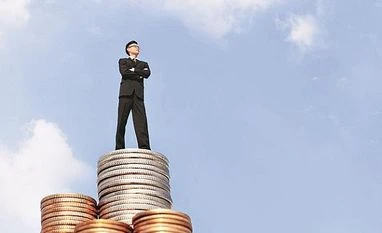The increased borrowing of Rs 12 trillion for 2020-21 against the budgeted Rs 7.8 trillion will widen the Centre’s fiscal deficit sharply and may increase inflationary pressure.
However, the government will get the funds to spur the sagging economy and take care of the health sector, needed for battling Covid-19.
The fiscal deficit will widen to around 5.3 per cent of gross domestic product (GDP), against 3.5 per cent estimated in the Budget for 2020-21 if one assumes the economy will grow by 10 per cent at current prices, also estimated in the Budget.
However, in the current circumstances it is difficult for the economy to grow at 10 per cent in nominal terms.
There are various estimates of economic growth, with the latest by Nomura stating economic contraction at 5.2 per cent in FY21. Even if one takes the upper range of the finance ministry’s optimistic projection of 2-3 per cent and assumes an inflation rate of 4 per cent, which falls mid-way in the Reserve Bank of India’s (RBI’s) mandate range, the Centre’s fiscal deficit would be 5.5 per cent.
This is based on the assumption that the economy has grown at 7.5 per cent in 2019-20, which the Budget has assumed.
Former RBI governor Bimal Jalan said the central bank had done something that needed to be done in the current circumstances. “Look at the circumstances. These are not normal,” he said.
He did not think the move would crowd out private borrowing and said the demand of the government and the private sector did not come into conflict with each other.
Former economic affairs secretary R Gopalan said the additional money was being borrowed from the market to meet the shortfall in tax and non-tax revenues and to finance additional government expenditure.
“Unfortunately, we don’t have information on how much is going into what,” he said.
It is believed the government will come up with its second package but it will be mainly for rural areas and micro, small and medium enterprises.
The Confederation of Indian Industry on Friday asked for a package of Rs 15 trillion.
For financial stability, it is important to know how the yield curve is going to be maintained. State government borrowing is to be enhanced, Gopalan said.
The position on using unconventional methods is unclear because it depends on shortfall in revenues and additional expenditure, he said.
Former financial services secretary D K Mittal said the fiscal deficit would increase and there would be inflationary pressure. But much depends on how the government is going to utilise this additional Rs 4.2 trillion, he said.
“But if it is spent on subsidies, it will raise inflation,” Mittal said. The government may give part of the money as loans to businesses and not grants.
“Businesses can start in 15 days, in three months, and in years. For instance, hospitality and aviation will take a number of years to revive. These sectors will have to be restructured. Banks are not giving loans to them. So they have to be given loans, maybe at lower interest rates, say, at g-sec plus and for a longer tenor,” he said.
Part of the funds can go into infra spending, inviting foreign investment in special economic zones, and initiating reforms, Mittal said. Reforms could include having smart meters in every electricity connection, and that will take care of many problems like discoms’ losses and power supply, he said.
While Madan Sabnavis, chief economist at CARE Ratings, says the Centre’s fiscal deficit in the changed conditions will widen to 5.5 per cent for the current financial year, Soumya Kanti Ghosh, chief economic advisor at the SBI group, says it will go up to 7 per cent as the government will have to borrow an additional Rs 3-4 trillion, which may include monetising the deficit.
However, Sabnavis said a takeaway was that the RBI had no intention of lending directly to the government at present. He said the surplus money going into reverse repo could now be diverted to g-secs, which make a safe avenue for parking surplus funds. Gopalan said the rate that banks got through reverse repo was 3.75 per cent. They will now get around 2.5 per cent more by parking money in government papers.
According to Sabnavis, tax collection has been budgeted at Rs 24.23 trillion for 2020-21. Of that, Rs 7.84 trillion goes to the states. The two months of lockdown has put Rs 4 trillion (extra borrowing) under pressure, and with not more than 20 per cent of it attainable, this will be a pressure point.
He said disinvestment was budgeted at Rs 2.1 trillion, which looks very difficult and the best that can be done was having one public-sector undertaking buying into another because the main targets — Air India and Bharat Petroleum Corporation — may not get their right value now. On the other hand, expenditure will rise because the first package of the government — Rs 1.7 trillion — was outside the Budget.
Unlock 30+ premium stories daily hand-picked by our editors, across devices on browser and app.
Pick your 5 favourite companies, get a daily email with all news updates on them.
Full access to our intuitive epaper - clip, save, share articles from any device; newspaper archives from 2006.
Preferential invites to Business Standard events.
Curated newsletters on markets, personal finance, policy & politics, start-ups, technology, and more.
)